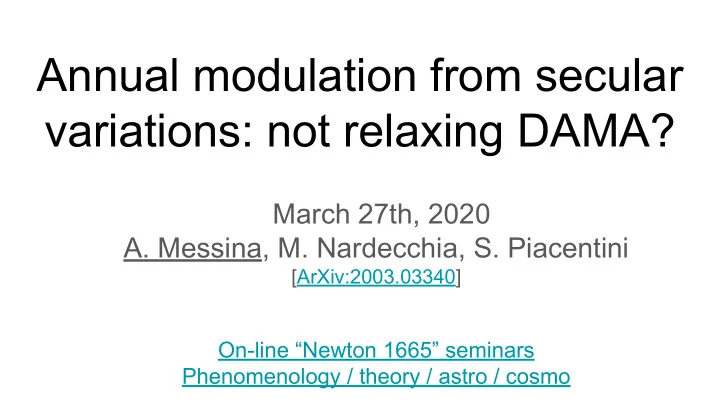

Annual modulation from secular variations: not relaxing DAMA? March 27th, 2020 A. Messina, M. Nardecchia, S. Piacentini [ArXiv:2003.03340] On-line “Newton 1665” seminars Phenomenology / theory / astro / cosmo
Why? ● Because by eye the sawtooth [Buttazzo et al. ArXiv:2002.00459] cannot reproduce much more than the period of the data! ● Can we be quantitative? 2
DAMA/NaI and DAMA/LIBRA data ● DAMA/NaI: 100kg NaI(TI), 7 yr, exposure = 0.29 ton yr R. Bernabei et al., Phys. Lett. B480 23-31 (2000). ● DAMA/LIBRA I: 250 kg NaI(TI), 7 yr, exposure = 1.04 ton yr R. Bernabei et al., Phys. J. C56, 333 (2008), arXiv:0804.2741 [astro-ph]. ● DAMA/LIBRA II: exposure 1.13 ton yr R. Bernabei et al., Nucl. Phys. At. Energy 19 (2018) 307, arXiv:1805.10486 [hep-ex]. Single-hit k : energy index j : detector index residual rate i : time index definition R. Bernabei et al., Riv. Nuovo Cim. 26N.1, 1-73 (2003) [arXiv:astro-ph/0307403]. ‘flat_jk’ is the background specific to each crystal, it subtracted before combining them. However, there is no reason to compute flat_jk on the whole cycle. If ‘flat_ijk’ is linear for instance, then one generates a sawtooth-like signal with period equal to the cycle. 3
Model comparison: models Naive likelihood: one data cycle ~ 1yr 2 simple, well defined models: ● COS: 1 free intensity Fixed to DM parameter ● SAW: 4
Model comparison: (Bayesian) strategy ● Assign to each model a prior probability: ● Use the data to update the odds ratio: Posterior odds Bayes Factor Prior odds ● For parametric models, is the likelihood averaged over the parameters (not the best fit (profiled)), for symmetric cases: , OF: ockham’s factor (parameters dependent) 5
Model comparison: Bayes Factor Maximum likelihood ratio ● For the frequentistic: ● OF: is the Ockham’s factor that penalises models with unnecessary complexity (parameters) ● =100 means that after having seen the fit you ‘should’ prefer 100 times more model A than what you did before. 6
7
DAMA/LIBRA I DAMA/LIBRA II DAMA/NaI 8
Fit t0, T, A of the COS+SAW model Compatible with: T= 1 yr, t0 = 2nd July (0.418 yr) T t0 A B1 B2 B3 9
Possible bias in the signal subtraction To remove bkgd, the rate is averaged over time and subtracted: If the time interval (ti, Delta) is different than 1 yr or not ‘symmetric’, you subtract some signal as well: 10
DAMA does removes asymmetric datasets to avoid this problem You know what you are subtracting and thus can correct for it! Up to 10% effects in the data cycles used by DAMA 11
Suggested fitting procedure T, t0 fixed to DM Free T, t0 12
Conclusions ● The DAMA residual modulation cannot be possibly explained by a slowly time-varying background (BF~1E8) ● There is no need to have data taking cycles of one year duration as DAMA has done in the past ● We suggest to include the 2 above effects in the fit! 13
Additional material 14
DAMA/NaI fit 15
DAMA/LIBRA I fit 16
Comparative results 17
Comparative results 18
Marginal posterior for COS+SAW on DAMA/LIBRA II ( T,t0 fixed) 19
Priors, posteriors and likelihood for COS and SAW on DAMA/LIBRA II 20
Recommend
More recommend